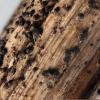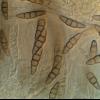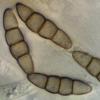
17-02-2014 16:57
 Chris Yeates
Chris Yeates
I have collected a Leptosphaeria on the dead stem-

15-02-2014 13:40
 Joop van der Lee
Joop van der Lee
Found on cow dung.Spores: 4.5-5x2.5-3 um

29-11-2013 13:07
Found at 28-11-13, Attica Greece, in sandy soil, f

14-02-2014 10:50
Stefan BlaserHello everybody Can anyone give me some advice on

11-02-2014 18:29
Hello forum Someone have a pdf of this paper ?: W
Leptosphaeria puzzle
Chris Yeates,
17-02-2014 16:57
 I have collected a Leptosphaeria on the dead stem-bases of last year's Tanacetum vulgare.The spores are almost all 3-septate, with a few developing a fourth, and a very few developing a fifth septum. Spore measurements are 19.1-23.9 x 5-5.7µm, in other words perfect for L. doliolum; however try as I might I cannot see evidence of the concentric ridge(s) on the pseudothecia which I would expect on that species, whether they are occuring below the stem cortex or on the bare stems. Photo's below: any suggestions welcome.
I have collected a Leptosphaeria on the dead stem-bases of last year's Tanacetum vulgare.The spores are almost all 3-septate, with a few developing a fourth, and a very few developing a fifth septum. Spore measurements are 19.1-23.9 x 5-5.7µm, in other words perfect for L. doliolum; however try as I might I cannot see evidence of the concentric ridge(s) on the pseudothecia which I would expect on that species, whether they are occuring below the stem cortex or on the bare stems. Photo's below: any suggestions welcome.Chris




